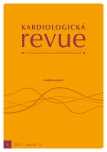Peripartum cardiomyopathy
Authors:
J. Krejčí
Authors‘ workplace:
I. interní kardioangiologická klinika FN u sv. Anny – ICRC, Brno
Published in:
Kardiol Rev Int Med 2011, 13(4): 221-224
Overview
Peripartum cardiomyopathy is a disease characterized by systolic heart failure occurring towards the end of pregnancy and in the months following delivery and excluding other aetiology of this condition. It is a rare disease whose incidence varies, according to data from USA, in the range of 1 case per 2,000–4,000 births, with incidence in some regions of the world being up to 10 times higher. The clinical picture corresponds to that of other causes of heart failure; the rapid development of symptoms in relation to pregnancy is notable. A major diagnostic procedure is echocardiography, while cardiac magnetic resonance imaging could be beneficial and endomyocardial biopsy is sometimes performed. The aetiology of the disease is unclear and most speculation concerns myocarditis, autoimmune involvement, cardiotropic viral infection, abnormal response to haemodynamic and hormonal changes during pregnancy and also, currently, increased levels of oxidative stress, inducing production of proapoptotic, proinflammatory and angiostatic mediators. While the restoration of left ventricular function is seen in 25–50% of cases, the outcome is sometimes fatal or requires a heart transplant. In addition to standard therapy for heart failure, other therapeutic concepts (pentoxifylline, bromocriptine and immunomodulation) are also undergoing tests. Recurrence of the disease in subsequent pregnancies is common and therefore further pregnancies are not recommended in the majority of cases.
Keywords:
peripartum cardiomyopathy – aetiology – diagnosis – treatment
Sources
1. Sliwa K, Hilfiker-Kleiner D, Petrie MC et al. Heart Failure Association of the European Society of Cardiology Working Group on Peripartum Cardiomyopathy. Current state of knowledge on aetiology, diagnosis, management, and therapy of peripartum cardiomyopathy: a position statement from the Heart Failure Association of the European Society of Cardiology Working Group on peripartum cardiomyopathy. Eur J Heart Fail 2010; 12: 767–778.
2. Ramaraj R, Sorrell VL. Peripartum cardiomyopathy: Causes, diagnosis, and treatment. Cleve Clin J Med 2009; 76: 289–296.
3. Elliott P, Andersson B, Arbustini E et al. Classification of the cardiomyopathies: a position statement from the European Society of Cardiology Working Group on Myocardial and Pericardial Diseases. Eur Heart J 2008; 29: 270–276.
4. Maron BJ, Towbin JA, Thiene G et al. American Heart Association; Council on Clinical Cardiology, Heart Failure and Transplantation Committee; Quality of Care and Outcomes Research and Functional Genomics and Translational Biology Interdisciplinary Working Groups; Council on Epidemiology and Prevention. Contemporary definitions and classification of the cardiomyopathies. An American Heart Association scientific statement from the Council on clinical cardiology, Heart Failure and Transplantation Committee; Quality of care and outcomes research and functional genomics and translational biology interdisciplinary working groups; and Council on epidemiology and prevention. Circulation 2006; 113: 1807–1816.
5. Van Spaendonck-Zwarts KY, Van Tintelen JP, Van Veldhuisen DJ et al. Peripartum cardiomyopathy as a part of familial dilated cardiomyopathy. Circulation 2010; 121: 2169–2175.
6. Elkayam U. Clinical characteristics of peripartum cardiomyopathy in the United States. Diagnosis, prognosis, and management. J Am Coll Cardiol 2011; 58: 659–670.
7. Abboud J, Murad Y, Chen-Scarabelli C et al. Peripartum cardiomyopathy: A comprehensive rewiew. Int J Cardiol 2007; 118: 295–303.
8. Sliwa K, Fett J, Elkayam U. Peripartum cardiomyopathy. Lancet 2006; 368: 687–693.
9. Nabhan A. Peripartum cardiomyopathy. ASJOG 2005; 2: 231–237.
10. Pearson GD, Veille JC, Rahimtoola S et al. Peripartum cardiomyopathy. National Heart, Lung, and Blood institute and Office of rare diseases (National institutes of health) workshop recommendations and rewiew. JAMA 2000; 283: 1183–1188.
11. Gentry MB, Dias JK, Luis A et al. African-american women have a higher risk for developing peripartum cardiomyopathy. J Am Coll Cardiol 2010; 55: 654–659.
12. Lamparter S, Pankuweit S, Maisch B. Clinical and imunologic characteristics in peripartum cardiomyopathy. Int J Cardiol 2007; 118: 14–20.
13. Bültmann BD, Klingel K, Näbauer M et al. High prevalence of viral genomes and inflammation in peripartum cardiomyopathy. Am J Obstet Gynecol 2005; 193: 363–365.
14. Midei MG, DeMent SH, Feldman AM et al. Peripartum myocarditis and cardiomyopathy. Circulation 1990; 81: 922–928.
15. Kühl U, Pauschinger M, Schwimmbeck PL et al. Interoferon-β treatment eliminates cardiotropic viruses and improves left ventricular function in patients with myocardial persistence of viral genomes and left ventricular dysfunction. Circulation 2003; 107: 2793–2798.
16. Hilfiker-Kleiner D, Sliwa K, Drexler H. Peripartum cardiomyopathy: Recent insights in its pathophysiology. Trends Cardiovasc Med 2008; 18: 173–179.
17. Sliwa K, Skudicky D, Candy G et al. The addition of pentoxiphylline to conventional therapy improves outcome in patients with peripartum cardiomyopathy. Eur J Hear Fail 2002; 4: 305–309.
18. Sliwa K, Blauwet L, Tibazarwa K et al. Evaluation of bromocriptin in the treatment of acute severe peripartum cardiomyopathy. A proof-of-concept pilot study. Circulation 2010; 121: 1465–1473.
19. Wojnicz R, Nowalany-Kozielska E, Wojciechowska C et al. Randomized, placebo-controled study for immunosuppressive treatment of inflammatory dilated cardiomyopathy: two-year follow-up results. Circulation 2001; 104: 39–45.
20. Frustaci A, Russo MA, Chimenti C. Randomized study on the efficacy of immunosuppressive therapy in patients with virus-negative inflammatory cardiomyopathy: the TIMIC study. Eur Heart J 2009; 30: 1995–2002.
21. Bozkurt B, Villaneuva FS, Holubkov R et al. Intravenous immune globulin in therapy of peripartum cardiomyopathy. J Am Coll Cardiol 1999; 4: 177–180.
22. Elkayam U, Tummala PP, Rao K et al. Maternal and fetal outcomes of subsequent pregnancies in women with peripartum cardiomyopathy. N Engl J Med 2001; 344: 1567–1571.
Labels
Paediatric cardiology Internal medicine Cardiac surgery CardiologyArticle was published in
Cardiology Review

2011 Issue 4
Most read in this issue
- There’s no hypertrophy like hypertrophy, or don’t forget amyloidosis
- Pericardial calcification
- Non-sarcomeric hypertrophic cardiomyopathies in adults
- Peripartum cardiomyopathy
